Development of Computer Games
Info: 8133 words (33 pages) Dissertation
Published: 9th Dec 2019
Tagged: Video Games
Contents
Task 1 (LO AC 1.1, 1.2, 1.3, M3, D1)
Evaluating the characteristics of user interaction
The impact of computer-based gaming
Task 2 (LO AC 2.1, 2.2, 2.3, M1, M2, M3, D1, D2)
Task 1 (LO AC 1.1, 1.2, 1.3, M3, D1)
In the form of a report, present research in an appropriate format discussing computer games development.
Computer Games Development
This report will look at several areas of computer games development as an introduction. Computer games have been around since the 1950s, where computer scientists used simple games as part of their research. For example, in 1952 Alexander Douglas wrote a game to play noughts and crosses, called OXO, for an EDSAC (Electronic Display Storage Automatic Calculator) computer at Cambridge University,
“OXO allowed a player to choose to start or to allow the machine to make the first move. Using a rotary telephone dial to enter their moves, the EDSAC would display the game board on a 35 x 15 dot cathode ray tube. Few outside of Cambridge ever played OXO” (computer_history_museum, 2018).
Below is a screenshot of OXO:

Screenshot from: http://www.computerhistory.org/timeline/graphics-games/
As computer games developed over the intervening years they included games on computers and specialised consoles, as well as other devices such as mobile phones, they improved in playability and quality. They also divulged into many different games types or genres and drove the creation of better hardware, such as Video Graphics capabilities, to keep up with the demand for better and more realistic games.
As well as increased video and sound capabilities, game production has also resulted in the games themselves being created for and adapted to many user interaction scenarios. Being used on a computer via mouse and keyboard, to being used on a mobile phone using touchscreen technology. Games have found themselves accessible on almost every platform available, from phones and T. Vs to consoles and supercomputers.
But with the increase of games and their ease of availability there have arisen problems. Especially with socioeconomic impacts and the impact, whether good or bad, on user’s skills development. And the effects arising for the creators of games.
Let us have a look at some of the modern games genres and some of the games platforms and developments.
Computer Games Genres
There are many types of games available to play. To help with classification of games they are split into genres. These genres though helpful are not always a good guide to a games classification as Apperley states
“the market-based categories of genre that have been developed in the context of video games obscure the new medium’s crucial defining feature” (Apperley, N.D).
And as there is no single standardised way to categorise games by genre, I have used the genres provided by statista.com and their list of the top ten most popular game genres in the U.K in 2014. (see image below).
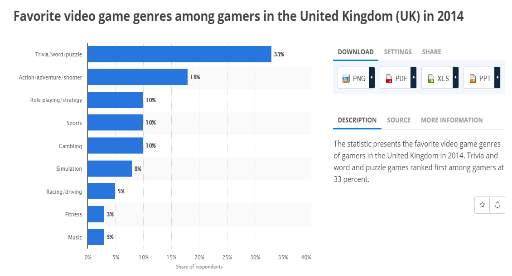
The list from the image is: Trivia/word puzzles, action, adventure, shooter; role playing, strategy, sports, gambling, simulation, racing/driving, fitness and music genres. Some of these genres are related to each other, and many games cross genres and some can even fuel the need for a new genre to be created. There are many sub-genres, so the list of genres could be a long and tiresome one. These are the reasons I have decided to limit the amount of game genres that I will look at.
Computer Game Genres
There are many types or genres of computer games, and many games in a genre have spread to form their own sub-genres. This splitting into sub-genres makes the classification of computer games such an uneasy task. But people who use games do like to know what genre a game is, to make it easier to purchase other, similar games. And, the companies creating games prefer them to fit into genres, so they can target their advertising to the customers who fit the profile of their game/genre.
Trivia/Word Puzzles
This genre includes many types of games and should be narrowed down to just the puzzle genre. It is more specific in this instance because of the groupings for the survey at statista.com. Puzzle games focus on the solving of puzzles, they exist in many formats such as strategic, tactical, logical, trivia and word puzzles.

Image from: https://4.bp.blogspot.com/-lpm__UXhkw4/VwlEv3hKrlI/AAAAAAAAHRI/I9UeTBu5AMwI8J5Et5qTwEDWl0vhuhiIA/s1600/puzzle-games.jpg
As mentioned above, there are a large variety of puzzle games, and as they are relatively straight forward to develop and adapt, they can be found on many platforms such as arcade units, video game consoles, tablets and mobile phones.
There are several types of puzzle game. Action puzzles involve players move game pieces to solve puzzles or clear a level. This is a broad type of puzzle game and includes games with falling blocks (such as Tetris), with characters moving through a level (Lemmings). And this type of game could also include Action games that require players to solve pattern matching or logic skills to progress through the game. Hidden Object games are games that the user must find a list of objects hidden in a scene. Hidden object games are popular with casual gamers, but as they are essentially the same thing repeated, they can be quite repetitive. To combat this hidden object game creators have incorporated mini-games of different puzzle types to break up the monotony. Physics Puzzle games are where users must use the games physics to complete the game. Although not always, most physic games use real world physics to make them more challenging. An example of a physics game is Angry Birds by Rovio Entertainment. Tile Matching games the player manipulates tiles to make them disappear. In this game type are games such as Tetris, Bejewelled and Mah-jong type games. Finally, there Traditional Puzzle game types, and these include crosswords, solitaire and other card games; quizzes and number puzzles.
Action Games/Adventure/Shooter

Image from: https://gaurnikhil.wordpress.com/2012/10/21/resident-evil-4-cd-keys/
Games in the Action genre typically centre on challenging the users’ reflexes, hand-eye coordination and reaction times. These are generally tested with running, jumping and attacking moves to complete levels. Users move from a character or avatar level to level, with the difficulty increasing at each level, towards the final level. There are usually bosses to defeat along the way, and in many games of this genre, mid-level bosses are used too. Progressing through the game you must watch the characters health levels and lives. When the character takes multiple ‘hits’ the character dies and loses a life, when all lives are lost the game is over. More lives and/or health can be collected throughout the game, although there are twists on this health-and-lives reward
“…some developers feel that it’s an archaic hold-over from an age where people dropped quarters into arcade machines to keep on playing. In the independently-developed action game Braid, for instance, players can “rewind” the gameplay and correct the mistakes that led to the main character’s death” (Oxford, 2017).
Games of this genre are very popular, and because of this they are available to play on many platforms, including games consoles, mobile phones and P.Cs. And because of this popularity this genre has split into several sub-genres due to developers playing around with the basic formula of the genre. Some of the sub-genres are: Shooter Games, where the user must shoot opponents, in some games using specific controllers in the shape of a gun. Beat ‘em ups, where the character moves from left to right fighting many opponents using close-range melee’ attacks and finally Platform Games, which is probably the most well-known and popular of the sub-genres, where the character progresses through levels of obstacles, floating platforms, enemies and bosses.
Adventure games
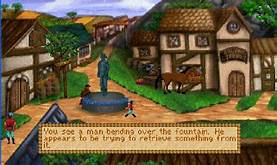
Picture from: http://games4article.weebly.com/adventure.html
Though tied in with Action and shooter games in the statista.com listing, it is a genre all its own in many genres lists but has also spawned a sub-genre with Action games, called the Action-Adventure genre, which I will mention below after the description of Adventure games.
Adventure games have an emphasis on story and character, rather than challenging users’ attributes. The essential elements of an adventure game are storytelling, exploration and puzzle solving. Adventure games (also known as point and click games) usually provide control of one character that interacts with the game world by moving to and from areas, asking questions and solving puzzles. In the beginning adventure games were text based only, with the game providing a narrative and users selecting a direction or action for the character to perform. This progressed to graphics being used to enhance the narrative but still with text descriptions and commands; and then onto a fully graphic world where a mouse is used to point at relevant areas and to complete tasks, hence the point and click name. Current adventure games include fully immersive graphic worlds with full motion video cut screens.
Because of their popularity, adventure games are available on many platforms including home computers, consoles and hand-held devices. With the increase of the mobile phone market, adventure games have enjoyed an upsurge on mobile phones, providing an enjoyable and easy to play game that can be played for short periods of time and the games saved for later play.
Action-adventure games blend action and adventure games throughout the game, incorporating more physical challenges than pure adventure games and a faster pace too. Action-adventure games normally include a combination of story elements, which are presented to players using audio and video. The story is heavily reliant upon the player character’s movement, which triggers story events and affect the flow of the game, the Tomb Raider series of games are a good example of an action-adventure game.
Role-Playing Games (RPG)
An RPG is a video game genre where the player controls the actions of a character or characters immersed in some well-defined world. Many role-playing video games have origins in table-top role-playing games like Dungeons & Dragons, and use the same terminology, settings and game mechanics; as well as story-telling and narrative elements, player character development and complexity. The electronic medium removes the necessity for a “gamemaster” (from Dungeons and Dragons) and increases combat speed. RPGs have evolved from simple text-based games into visually rich 3D programs.
Players explore a game world while solving puzzles and engaging in combat. A key feature of the genre is that characters grow in power and abilities. RPGs rarely challenge a player’s physical coordination or reaction time such as in action games. Role-playing video games typically rely on a highly developed story and settings which are divided into several quests. Players control one or more characters by issuing commands which are performed by the character at an effectiveness determined by numeric attributes. These attributes increase each time a character gains a level. Role-playing video games also typically try to offer more complex character interaction than what is found in other video game types (Wikipedia.org, 2018).
The fighting mechanics in RPG games leads them to be generally split into two types, turn-based and real time. In turn-based RPGs only one character may act at a time; all other characters remain still. The order in which the characters act is usually dependent on their attributes, such as speed or agility. This system rewards strategic planning more than quickness. In real time games features from action games have been used to create free turn fighting, creating a hybrid action RPG game genre.
But other RPG battle systems such as the Final Fantasy battle systems have imported real-time choices without emphasizing coordination or reflexes. Other systems combine real-time combat with the ability to pause the game and issue orders to all characters under his/her control; when the game is unpaused, all characters follow the orders they were given” (Wikipedia.org, 2018).
RPG games are generally played on home computers and consoles, although there are versions available on mobile phones that provide a much-restricted version of the genre.
Strategy Games
Strategy games place an emphasis on planning tactically or strategically to complete the games. Many of these games also include logistical and economic challenges and the need for exploration. Strategy games can be turn-based and real-time and could also be split into tactical and strategic sub-genres as the amount of games available is quite large that are specially devoted to either types (tactic or strategy) of the game employed. A strategy game is typically large in scope, and the main emphasis is on the player’s ability to outthink their opponent. Strategy games rarely involve a physical challenge. Compared to other genres such as action or adventure games where one player takes on many enemies, strategy games usually involve some level of equality between sides. Each side generally has access to similar resources and actions, with the strengths and weaknesses of each side being generally balanced.
Although strategy games involve strategic, tactical, and sometimes logistical challenges, they are distinct from puzzle games. A strategy game calls for planning around a conflict between players, whereas puzzle games call for planning in isolation. Although strategy games are like role-playing video games in that the player must manage units with a variety of numeric attributes, RPGs tend to be about a smaller number of unique characters, while strategy games focus on larger numbers of similar units.
Strategy games are generally played on home computers and consoles, although there are versions available on mobile phones that provide a much-restricted version of the genre.
Sports Games
Sports games involve physical and tactical challenges and test the player’s precision and accuracy. Most sports games attempt to model the athletic characteristics required by that sport, including speed, strength, acceleration, accuracy, and so on. As with their respective sports, these games take place in a stadium or arena with clear boundaries. The user gets to either control a player or groups of players in an action type sports game, or the user can take the role of a manager and run a team in a strategy type of game. As can be seen, sports games tend to involve the merging of several game genres to produce them, and as such sports games should be seen rather as a sub-genre of several other genres, and not its own genre as listed in the chart at the beginning of this section.
Gambling Games
Although gambling games is listed as a game genre in the statist.com list, I have found that it is more of a sub-genre that lends itself to puzzle games and strategy games. These games bring casino style games, such as slot machines and card games as well as traditional gambling on sports, to the user. Some of these games allow the user to bet their own money on the outcome of the games and are usually produced by established gambling operators. Others, especially on mobile phones, allow the user to gamble pretend money, but with the ability to buy pretend money to use on the game.
Although these games are popular, they do cause some controversy because they bring gambling to people easier, and even though they are age restricted, the restrictions are not in built-in to many of the games and could allow under age people to gamble.
Simulations
Simulation games attempt to copy activities from modern life in game form. These simulations can be used to help training, analysis and prediction of events as well as providing the usual game benefits. Simulations are used to train people in say flying a plane or driving and a train, and as such these games do not put an emphasis on enjoyment and satisfaction of the user, instead they concentrate on providing as real an experience as possible and providing a learning experience in a safe environment. Other forms of simulation games provide a more traditional game like experience, games such as The SIMS introduce gaming mechanics to make controlling a character in a real-life situation more fun rather than educational. Although, it has been shown that players of games such as SIMCITY have more sympathy with government and local government due to their experiences controlling a city in a game (ZeynepTanes, 2010), thus showing that even playing the fun simulations can have an effect that mirrors the effect of more serious simulators. Under the simulation umbrella, games which simulate sports (such as football games, racing games and piloting games) are listed. The statista.com list includes racing games as a separate category, but as they are simulation games or in many instances action games, listing racing games as a separate genre would create a web of sub-genres that could complicate any classification.
Fitness and Music
In the statista.com list I am following, they have listed these as separate genres, but after looking on the internet it has become obvious that they share the same genre. Fitness games allow users to follow instructions in how to exercise and often include programs to follow, tracking of exercises and dietary recommendations. Music games allow users to either dance to music following patterns to earn points, or to follow keypad directions to play a musical instrument. Both these game types follow the same type of game play, especially on consoles that follow the users’ movements rather than using a handheld controller to complete instructions.
Game platforms
“A game platform (also called a videogame platform or videogame system) refers to the specific combination of electronic or computer hardware which, in conjunction with software, allows a videogame to operate” (Wiki, 2018).
There are many platforms that games can be run on. In the beginning games were created to run on mainframe computers and were an exercise in what can be done. Modern games must be created to be run on multiple platforms with differing processing power, and the choice of platform to the user is vast, and games can be found on some of the strangest of platforms (T.V for example).
Arcade Games Platform

Arcade games (or coin-op) are entertainment machines that are usually found in arcades and other business areas. Arcade games include video games as well as traditional games such as pinball machines. Arcade games have progressed from early types, such as electro-mechanical games like Duck Hunt in the 60s and are now video game based. The arcade game machines use hardware like high-end home PCs or consoles. These arcade games dramatically introduced video gaming to the public, providing a high revenue stream for their creators due to their popularity. With the advent of home console systems bringing arcade quality games to the home, the demand for arcade games has waned, although an increase in popularity has arisen due to the popularity of martial arts style fighting games and a resurgence in retro games such as space invaders.
Console Games Platform

A console is a machine that allows the playing of video computer games at home via a TV, rather than at an arcade. Unlike most modern computer technology, consoles use proprietary hardware and software formats and the companies that produce compete for market share. There various types of gaming consoles, from home-based units to handheld units (which are discussed in the below section). The first home console was developed in 1966, but it was not until ten years later that the Pong game made them desirable and popular in the home. Over time games consoles have evolved to provide better quality graphics and sound, more features such as internet access and TV access and different types of media, progressing from cartridges and chip cards to DVDs and online sales specific to the game console type. As console design and improvement has increased since their creation below is a timeline, split into generations, of console development.

Chart from: https://en.wikipedia.org/wiki/Video_game_console
First generation consoles appeared from 1970s, and where machines dedicated to games that came with the console. Second generation consoles improved on the first-generation consoles by providing a selection of games on cartridges, better graphics, colours and sounds, better AI simulation for games and multiple levels in games. Third generation consoles (also known as 8bit generation) came with specialised controllers known as D-pads rather than a joystick, had improved screen resolutions, a lot more colours, better scrolling and hardware processing and better sound quality but still mono. Fourth generation consoles (also known as 16bit generation) came with CD games storage (a notable exception was Nintendo and their SNES), much improved graphics and sound capability (stereo sound with multiple channels), more colours and 3D polygon graphics and scrolling. Fifth generation systems brought full CD-ROM game storage to all consoles, Cd quality sounds on games, Full Motion Video in games either showing live action on graphic rendered videos, better 3D graphics capabilities including shading and filtering; and texture mapping. Sixth generation consoles updated many of the previous enhancements and included DVD-ROMS rather than CD as game media and saw a breakthrough of the modern games consoles such as the Playstation2 and Xbox. This generation saw a large percentage of consumers buying consoles and the Playstation2 was the most popular.
Each Seventh-generation console introduced a new type of breakthrough in technology. The Xbox 360 offered games rendered at high-definition, the PlayStation 3 offered HD movie playback via a 3D Blu-ray Disc player, and the Wii had controllers with movement sensors as well as a control pad, which enabled players to simulate real-world actions during gameplay (e.g., in the Wii sports tennis game, the user swings the controller to hit the on-screen image of a tennis ball). Video game consoles had become an important part of the global IT infrastructure and their sales showed this. The development of home-based consoles lead to the development of handheld devices.
Handheld video game

Handheld video game systems are self-contained game consoles, they are smaller than the home-based consoles and have a screen, controls and speakers in one easy to carry unit. As with homebased-consoles, handheld consoles were first developed to play whatever game(s) came with the device. But with the development of cartridges for the home-based systems, the use of the cartridges gave the handheld devices the same scope for easy game swapping. There have been many types of handheld gaming consoles, all are limited by their size and technology to the standard of game that can be played, until recent times that is.
These days handheld gaming is performed over several types of devices; the handheld consoles, mobile phones/tablets (talked about in the mobile game section below) and PDAs which are more in the past than the present but did highlight the popularity of mobile gaming.
Multiplayer online games
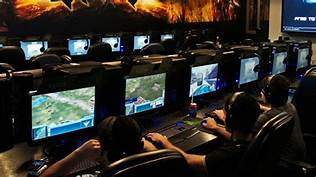
Multiplayer games have been available since the creation of computer games. With the introduction and increase of use of the internet, multiplayer games have branched out to use the internet and thus form their own online platform. Most of the online games come under the acronym MMOG which stands for Massively Multiplayer Online Game. These games are run from a server and can support large numbers of players simultaneously. The games run over these servers typically require users to sign up to membership which provides vast incomes for the companies creating and hosting the games. “In 2008, Western consumer spending on World of Warcraft represented a 58% share of the subscription MMOG market in 2009. The title has generated over $2.2 billion in cumulative consumer spending on subscriptions from 2005 through 2009” (Hardy-Rolls, 2009). The large amount of money that this gaming platform generates guarantees its continued use and ensures that the platforms developers maintain and keep it up to date.
This platforms attraction to users include providing a sense of belonging to a group and the interactions that occur through playing the games, feelings of achievement through rewards and the maintaining of rankings and score tables, unique benefits that are driven by different levels of membership which cost more for the customer. The games played on this platform have a wide variation. The classic definition of these games is seen akin to role playing games and first-person shooter games. But there are others that bring whole worlds to explore and interact with aimed at different audiences. For example, Disney run clubpenguin.com which is a huge online world that allows users to explore the world, play minigames and interact with other users,
“Latest figures suggest Club Penguin had over 12 million user accounts. While free memberships are available, revenue is predominantly raised through paid memberships (I think it was about $57.95 a year down to $5.95 per month), which allow players to access a range of additional features, such as the ability to purchase virtual clothing, furniture and “pets” (Laight, 2011).
This shows that MMOGs are big business and is the prime reason for businesses to venture into this market and invest in the technology to improve their online gaming environments.
Mobile game
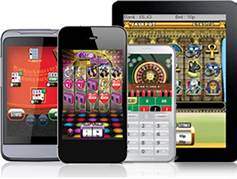
Mobile gaming takes place on mobile devices such as mobile phones and tablets. This gaming platform is more geared to shorter game play than the others mentioned above. This is due, among other reasons, to the time spaces that are available for users to play the games, which mainly consist in gaps in the day, such as train and bus journeys, waiting for something and periods of boredom. Mobile games tend to be small and prioritise design and ease of play over visual appeal. Storage and memory limitations place restrictions on file size that rule out the complete conversion of PC and console games to mobile devices.
Mobile gaming started with the advent of the mobile phones and PDAs. The first games were simple games that utilised the phones numeric pad monochrome screens (e.g. snake on Nokia phones). The rise of WAP (Web Access Protocol) on phones lead to the ability of users to download games to their phones and use basic multiplayer games. Other services became available on mobile phones that allowed for better graphics and gameplay (such as J2ME, JAVA and Flash support) especially with the development of colour screens.
There were several attempts at producing a mobile phone that looks and plays like a handheld game console, but many problems were encountered with poor design (such as the Nokia N-Gage). But parts of this development, such as the popular Nokia Ovi store, lead to Android and Apple app stores being created when an outlet for their apps was needed (Langshaw, 2011).
The more popular genres that are used on this platform are shown in the table below along with their estimated user amounts and the amount of time they are used.
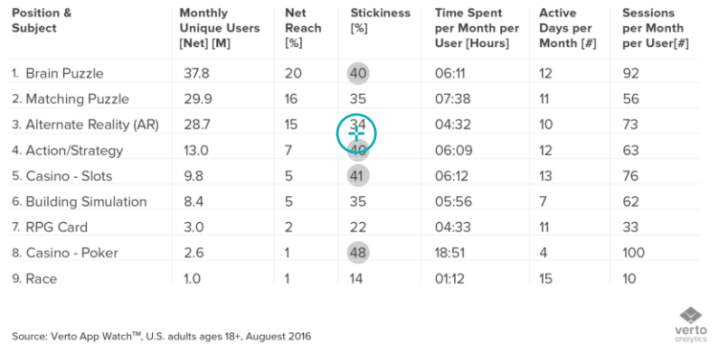
And if we compare this to the figures for consoles games we can see that there are marked differences in the time spent playing. The amount shown on the mobile is measured by hours per month, the console is measured per day.

These small bites of playing time on mobile games has an impact on the development of the games. They are developed to provide a quick hit, usually with the ability to save games for future use or the program autosaves when the program is shutdown to preserve the players progress.
Personal computer

The Personal Computer (PC), is the most configurable and upgradeable games platform for users. And among home gaming systems it offers the most control options, biggest game catalogue and has the best hardware available for the games. In the terms of home gaming, the PC is the oldest gaming platform in use today. The term PC relates to windows-based computers, and this is the most common operating system for games, but other PC types such as Apple Macs and Linux variants do have games on, but the size of the user base, although increasing, is still to low for major game developers to put much effort into increasing games catalogues on these other computer operating systems.
The upsides to using a PC for gaming include the ease of upgrading hardware to keep up with new game demands. Although the initial outlay of buying a PC for gaming is higher than buying a games console, the ability to install new video and sound cards instead of buying a new console to keep up with the advances in games, makes the PC platform an attractive option for gaming. Although much is made about the top end hardware available for gaming PCs, the reality is that to keep your PC abreast with the games available and with gaming consoles does not require any major outlay. Also, PC gaming can offer some benefits to game manufactures such as increased flexibility, increased innovation, easier modification creation and easier ability to update and patch the games (Lane, 2011).
Other Platforms
Web-Browsers have established themselves as platforms for gaming, with web-sites hosting games to play on-line through the website. This provides a cross-platform audience for games across PCs, Mobile phones and tablets, and across multiple operating systems (Windows, Android, IOS etc.).
Graphing calculators have been used as a platform for games for many years and still have a loyal following.
Though designed to produce graphs and other technical diagrams, they can be easily programmed, and this has led to many sites dedicated to graphing gaming, and as the calculators have internet connection for sharing graphing data, the games can be easily downloaded to.
Evaluating the characteristics of user interaction
To play a video game the user needs a way to interact with the game. The platform used and in some instances the game being played makes a difference on the device used for interaction. For example, many games consoles use a gamepad to control the games, but there can be variations that are specific to certain games, like a steering wheel for driving games or a light gun for shooting games. Below I will list several of these user control devices, their differences and similarities, and the platforms they are used on.
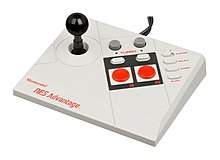
Arcade controllers are based on the controllers found on arcade game cabinets but for home gaming systems such as consoles and PCs. These were designed to provide the responsiveness and feel of an arcade machine at home. With the improvement and availability of games consoles in the home, a better designed and more ergonomic controller was needed. This led to the creation of the gamepad
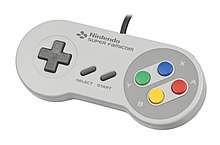
Gamepads came about as a way to control games without a bulky joystick or similar. The idea was first used by Nintendo for their NES game console (picture to the left), which the directional button cross (or D-pad) was taken from Nintendo’s Donkey Kong game. This proved such a popular format that all controllers for modern games consoles follow a similar pattern with the addition of analogue sticks for better multi-directional control. “gamepads essentially continued to follow the template set by the NES controller, a horizontally-oriented controller with two or more action buttons positioned for use with the right thumb, and a directional pad positioned for use with the left thumb” (Next-Generation, 1996).

The Joystick possibly started life as a controller for remote control flying of aircraft by C. B. Mirick at the United States Naval Research Laboratory (NRL) and patented in 1926, he described it as “My control system is particularly applicable in manoeuvring aircraft without a pilot” (USA Patent No. US001597416 , 1926). The Germans and Americans developed joystick type controls for remote piloting of missiles that used radio to transmit the controls from the joystick to the missile.
The first video games joystick was developed in 1967 for the Magnavox Odyssey games console and was used to control the X and Y axis of a spot on the screen. The first joystick with a fire button was released by Sega for use with their Missile Shooter arcade game in 1969. Atari developed a multi-directional joystick with a fire button in 1977 and was the standard joystick design for many years. Joysticks were the main controller for first and second generation games consoles but were replaced by the gamepads as primary controller. Joysticks are still popular for certain game types such as flight simulators and can still be purchased for modern games consoles.
Other uses for joysticks include being used to control cranes and other construction machinery, some aircraft have them as well as the usual control yoke and they are used to control wheelchairs and as a computer interaction device for disabled users instead of a mouse because it is easier to grip and control as opposed to mice.
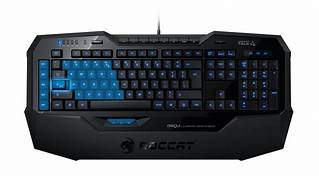
Keyboards have been the primary input medium for PCs and other devices since the use of punch cards declined in use with mainframe computers. Every computer user has a keyboard, but not every keyboard is useful when playing games, hence the creation of gaming keyboards (see picture). Gaming keyboards aim to provide a better user experience for gaming than a standard keyboard by adding game user friendly additions. Some keyboards offer a lighting system on the keyboard which provides a visual response when a key is pressed that denotes time and strength of a key push. Many gaming keyboards provide programmable keys that can be used to store a Macro of keypresses making a multiple key press in to one allowing the gamer quicker action times in games. Some keyboards come with a small screen on them that can be used for displaying mini maps and game stats or can be used for multitasking, so your eyes are not flicking from screen to keyboard as much. Some keyboards come with USB ports on them so the need for fiddling behind the computer to attach peripherals is reduced and many keyboards have onboard controls for volume and video control keys to minimise mouse use. In gaming the coupling of mouse and keyboard for many game genres is an important combo, and this has led to Gaming Mice being developed alongside Gaming Keyboards.
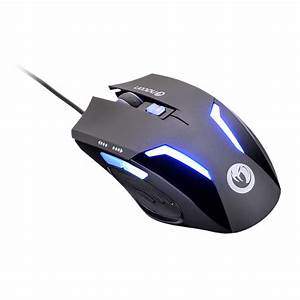
A Gaming mouse is designed with additional features to make it better suited to gaming. The additional features usually include programmable buttons, adjustable sensitivity, adjustable weight and better responsiveness. Although technically a gaming mouse will do the same things as a normal mouse, they do provide a higher level of accuracy and are more ergonomically designed. Gaming mice are also suitable for other uses such as computer aided design and computer graphics programs, which can make use of the extra buttons and programmable keys that many gaming mice have, as well as adjustable DPI settings that allow for more detailed use.

Though seen as a modern technology, Touchscreens have been with us since 1973 on the Plato IV touchscreen computer, it was by students and tutors at the University of Illinois and had limited touchscreen capabilities and was not used for gaming. The first touchscreen for gaming was on the Vectrex gaming console, this used a light pen to allow users to draw and interact with objects on the screen (Museum, N.D). The first handheld touchscreen device was the Apple Newton, and although the storage and technical points were not the best it had a large user base which enabled games such as Snake and Risk to be programmed and downloaded on to it (Milne, N.D). The most well-known use of a touchscreen for gaming was the Nintendo DS, with two screens but only one touch enabled. Though certainly not the first touchscreen gaming console it was the first to reach a mass audience and have a vast catalogue of games. After the development of the I-pod by Apple they devised the I-phone, which started off the craze of touchscreen mobile phones (FX, 2010). With support Apple provide to developers and customers allowed many apps to be made and downloaded. It also helped introduced the idea of mobile gaming as a serious prospect to customers and developers alike. Today touchscreens can be found on many devices including desktop PCs, televisions, phones, EPOS equipment, tablets and on teaching aids such as touchscreen whiteboards.
Touchscreens provide a very intuitive interface, you use a finger to select and control items on the screen. And for some games this provides an easy to use control interface for users, especially people who game on their mobile phones. But touchscreens do have some down sides for gaming. As most people play games on consoles and PCs still, the touchscreen has limitations when applied to consoles, especially with the need for the user to be in touching distance of the screen. Also, touchscreens are still not as responsive in gameplaying as the traditional controllers (Joystick, Gamepad, Mouse & Keyboard), even though attempts have been made to integrate touchscreens into controllers, users have not shown much interest in adopting them into game play on consoles and PCs. On the other hand, Sony has developed a touchscreen portable gaming console, which shows with a portable gaming solution, touchscreen is the preferred control system.

Virtual reality games require the use of a VR headset to display a 3D world to the user and sometimes handheld control units to allow the user to manipulate and interact with the 3D world. This games controller provides an immersive gameplay experience that brings the user into the game rather than viewing it from a screen. Although the headset provides the visual part of VR, control units are still required for any game interaction. There are many peripherals for VR gaming to make the experience more immersive, from gloves and hand-held controllers (as in the picture), to cradles that the user lies in to get the feel of flying, there are many devices to ‘plug into’. There are also companies who have developed portable VR kits to allow the user to move around whilst playing games, but these are bulky and get very hot, and require the user to be in a safe a secure area to play.
The impact of computer-based gaming.
Unit Specification Guidance:
Impact of gaming: concerns e.g. time spent, social isolation, cost, separation of reality from actuality, addiction; benefits e.g. development of thinking, skills development, social interaction, impact on device development, impact on device accessibility
Video games are a unique type of entertainment because they encourage users to become part of the game. Although they have been available for over thirty years, modern computer games require users to spend more time on them. People who play games engage in them on more physical and mental levels than someone who just watches television (Norcia, 2014).
There are many studies on the effects that video games have an the people playing them, and many of them concentrate on the effects on children and adolescents as these are the groups of users seen to be more susceptible to any influences. Indeed, after having read various reports you could be forgiven in thinking that computer games are played solely by young teenagers having their social and cognitive skills hampered or even changed by playing computer games.
“People of all ages play video games. There is no longer a ‘stereotype of game player,’ but instead a game player could be your grandparent, your boss or even your professor” (ESA, 2014)
Task 2 (LO AC 2.1, 2.2, 2.3, M1, M2, M3, D1, D2)
You are employed as a Gaming Engineer for the UK Games Development Consortium (UKGDC) based in Bolton. A prospective client has commissioned your firm to develop a game. The target audience is children at Key Stage 1 who suffer from issues relating to hand-eye coordination. The purpose of the game is to ultimately improve coordination. The game produced must be visually stimulating, increase in challenge over the duration of game play and should feature either a timer or scoring system.
Design a computer game for UKGDC; ensure you identify components and data structures. Additionally,
evaluate alternative designs and solutions.
To help with designing my game I used a Gantt chart to plan when and how long I could afford for each task. This structured plan helped me to keep to the deadline for the creation of the program.

As part of my research into the game I looked at what benefits can be taken from playing games, especially the benefits to hand-eye coordination. A study by Art Markman PhD that looked at video game play benefits coordination found that there are benefits to playing action computer games in relation to hand-eye coordination, he states
“This study suggests that playing action video games benefits hand-eye coordination. Playing these games requires reacting quickly and accurately to events that happen on the screen. This practice improves coordination in other tasks as well” (Markman, 2016)
I decided to design a simple action game that involved the user controlling a space ship to avoid falling asteroids. This game would allow for the use of hand-eye coordination in the action of controlling the spaceship and avoiding the asteroids. The storyboard for this concept is shown below.
Story Boards
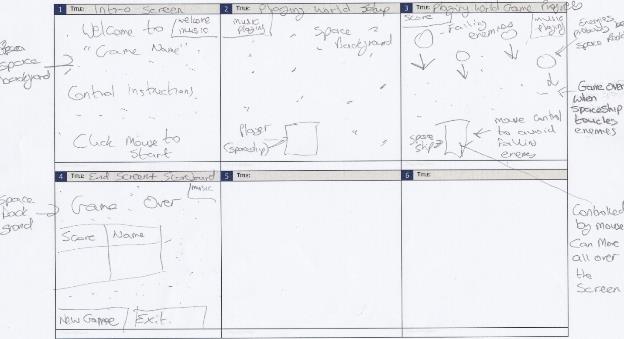
After showing my idea to several key stage 1 children, they expressed that the games characters did not appeal to the girls and the boys together. They expressed that the characters could be nicer, and the backgrounds should be nicer too. After this quick discussion I drew up another storyboard to include their ideas which is shown below.
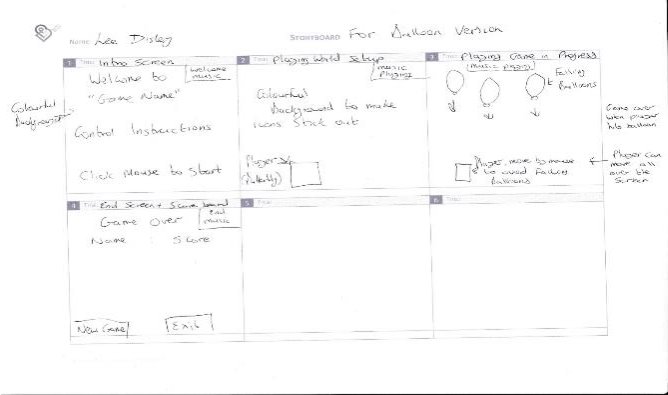
Pseudocode
Display Introduction World
Start Music
Accept players name
Wait for mouse click
On mouse click display Main world
Start Music
Place character in starting position
Display scoreboard
Start Game
Balloons start falling down screen at a rate of
When balloons fall off the screen they are removed from memory
When balloon has entered playing area add 1 to balloon count
When balloon count equals 20 and increments of 20 increase speed of balloons
When balloon count equals 20 and increments of 20 increase amount of balloons
When character touches balloon end of game world is shown
Play Music
End of Game world displays score and name
Wait for player to click mouse to restart game
Flow Chart
Below is my first flow chart that followed my pseudocode.
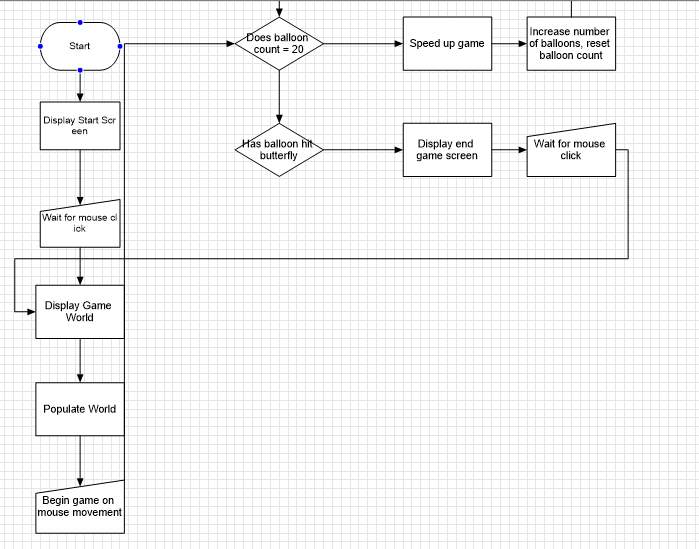
After looking at this I noticed a few problems with my proposed design. That there was no way to exit the program, and that I had not included a scoreboard so the player could see how well they were doing. I also noticed that I had not put any text on the decision areas to notify which line represented yes or no.
References
Apperley, T. H., N.D. Genre and game studies: Toward a critical approach to video game genres. [Online]
Available at: www.tomsphd.blogspot.com
[Accessed 10 01 2018].
computer_history_museum, 2018. Timeline of computer history. [Online]
Available at: http://www.computerhistory.org/timeline/1952/#169ebbe2ad45559efbc6eb35720d5707
[Accessed 09 01 2018].
Oxford, N., 2017. What’s the Definition of An Action Game?. [Online]
Available at: https://www.lifewire.com/nintendo-action-game-1126179
[Accessed 16 01 2018].
Cite This Work
To export a reference to this article please select a referencing stye below:
Related Services
View allRelated Content
All TagsContent relating to: "Video Games"
Video games are an electronic form of entertainment, typically played on a console, computer or other type of machine. Video games can be enjoyed by people of all ages regardless of interests, with games covering a wide range of genres.
Related Articles
DMCA / Removal Request
If you are the original writer of this dissertation and no longer wish to have your work published on the UKDiss.com website then please:




